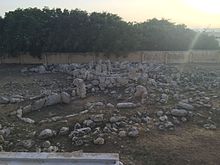Kordin III
 View of Kordin III | |
| Location | Corradino, Paola, Malta |
|---|---|
| Coordinates | 35°52′37.5″N14°30′32.4″E / 35.877083°N 14.509000°E |
| Type | Temple |
| Part of | Megalithic Temples of Malta |
| History | |
| Material | Limestone |
| Founded | c.3700 BC |
| Abandoned | c.2500 BC |
| Periods | Mġarr phase Ġgantija phase Tarxien phase |
| Site notes | |
| Excavation dates | 1870s–1961 2015–present |
| Archaeologists | Cesare Vassallo Antonio Annetto Caruana Thomas Ashby Thomas Eric Peet John Davies Evans David Trump Caroline Malone |
| Condition | Ruins (poorly preserved) |
| Ownership | Government of Malta |
| Management | Heritage Malta |
| Public access | By appointment |
Kordin III is the only temple on Corradino whose remains have survived. It is located just outside the Corradino Lines, close to the Church of St. Anthony of Padua and Mariam Al-Batool Mosque. [9]
Site
The Kordin III complex consists of two temples. The larger one has a standard 3-apse plan, typical of Ġgantija phase design. The temple has a concave facade, with the forecourt and entrance passage to the central court being stone-paved. This stone paving is unique to Kordin III, as this has not been found in any other temples of Malta. Behind the temple are some small rooms, which were possibly used as storerooms but could have also been an irregular minor temple. The first part of the temple is believed to have been built in around 3700 BC, during the Mġarr phase. Most of the structure dates back to the Ġgantija phase, and the complex was still in use during the Tarxien phase, when the facade was rebuilt. The site is believed to have been abandoned in around 2500 BC. [7]
A 2.75 metre-long trough was found lying across the entrance to the temple's left apse, and this is generally considered as the most notable feature of the site. The trough has seven deep transverse grooves produced by grinding. It is made of hard limestone brought from over 2 kilometres away so it is highly probable that it was for grinding corn (a multiple quern) and contemporary with the temple, rather than for grinding 'deffun', the traditional Maltese roofing material, which would make it considerably more recent. [10]
Excavations and recent history
The site was cleared from debris by Cesare Vassallo in the 1870s. Antonio Annetto Caruana discovered further clusters of megalithic monuments in the area in 1882, and the site was properly excavated by Thomas Ashby and Thomas Eric Peet in 1909. Other excavations were undertaken by John Davies Evans in 1953 and by David Trump in 1961. [11]
A walled enclosure was built around the temple in 1925, and it is kept locked to give it maximum protection. [12] Like Kordin I and II, the temple was also damaged in World War II, but its remains were not built over after the war and can still be seen today. [13]
Although in poor condition, the temple is one of the most complete of the minor temples. [14] In 2009, the viability of extending the World Heritage listing to Kordin III was examined. [15]
New excavations of the area around the temple began in 2015 by Caroline Malone and a team of students from the University of Malta. [16]
The site was managed by Fondazzjoni Wirt Artna until 2016, when it was handed to Heritage Malta. [17] It is open to the public by appointment. [18]